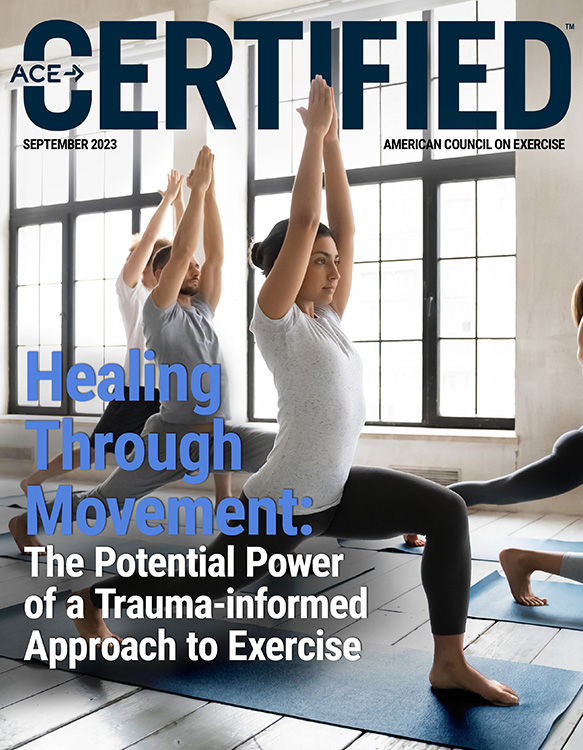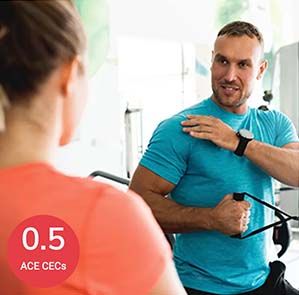
Strength training has long been touted for its muscle- and bone-building benefits, but a growing body of research suggests that enhanced brain health should be added to that list. In fact, skeletal muscle is now often referred to as the “organ of longevity.”
The principle of overload states that, for a muscle to grow, it must be stressed. This can happen in several ways, including:
- Mechanical tension, which happens when a muscle is subjected to a force that exceeds its current capacity. This can be achieved through an intense contraction or a stretch beyond current limits.
- Muscle damage caused by microscopic muscle tears that are often the result of eccentric loading.
- Metabolic stress, which involves altering the normal cellular environment through continuing a challenging physical effort beyond the duration to which the muscle is currently adapted.
The past few decades have brought an explosion of insightful research related to the benefits of strength training for brain health. Even better, we have learned enough to have confidence in how to apply what the research has revealed in the context of professional fitness instruction.
To be clear, while there is a significant amount of scientific research demonstrating these benefits, countless questions remain; for example, researchers have not yet identified the mechanisms—the how—of why strength training benefits the brain. Nor have they identified an optimal training program or volume that maximizes those benefits. Even if they don’t yet have all the answers, as a health and exercise professional, you can nevertheless make these benefits available to your clients through the types of muscular-training programs you design for them.
The purpose of this article is to provide you with a broad overview of the available research on the link between strength training and brain health and a bit of background on the mechanisms at work, as well as offer you some practical guidance on how to apply this research to your exercise program design and work with clients.
Strength Training and the Brain: A Review of the Literature
As mentioned earlier, the body of evidence linking strength training to brain benefits is growing, so the studies described below are hardly an exhaustive list. Rather, these studies were chosen for their compelling insight into how strength training can be used to enhance brain function and health, both in the short-term and throughout the aging process, and in individuals with and without brain disease. Also included are tips on how to apply these insights in unique ways in your clients’ resistance-training programs.
Better Brains Now—Improving Cognition
- A study by Chang and colleagues found that both an acute bout of high-intensity resistance training and combined moderate-intensity resistance and aerobic training significantly improved the performance on cognitive tests of 36 female college students, with combined low-intensity resistance training and moderate-intensity aerobic training being most effective at improving cognitive function
- Canadian researchers compared the effects of a once- or twice-a-week strength-training program to a twice-weekly balance and toning program among 155 females aged 65 to 75. The participants in both resistance-training groups demonstrated improved memory, enhanced selective attention and improved conflict resolution, whereas those who performed the balance and toning group did not experience the same improvements.
- In another study, women between the ages of 60 and 70 participated in a 12-exercise resistance-training program three days per week for 12 weeks. While the control group showed no improvements, the resistance-training group exhibited a 19% improvement in cognitive capacity in addition to improvements in muscular strength.
Better Brains Later—Preventing and Positively Impacting Brain Disease
- Researchers looked at the effects of progressive resistance training in 100 participants, age 55 and older with mild cognitive impairment. They found that six months of resistance training resulted in neuroprotective benefits to Alzheimer’s disease–vulnerable parts of the hippocampus.
- A literature review of 18 studies suggests that strength training has positive effects on brain health, structure and function.
- A study that focused specifically on older adults with mild cognitive impairment (MCI) concluded that high-intensity resistance training helps improve cognitive function in these individuals.
The Link Between Muscular Strength and Cognitive Functioning
- Researchers performed two physical and cognitive assessments, 10 years apart, on 324 healthy female twins. They found that leg power predicted both cognitive performance and aging and global brain volume, despite controlling for common genetics and early life environment.
- Coehlo and colleagues found that just one month of detraining erased the cognitive function and mobility benefits of a six-month resistance-training program in older women.
- A study out of Finland examined the link between upper-, lower- and total-body strength and cognition among aging men and women and concluded that muscle strength is associated with better cognition.
- In a study of more than one thousand women ages 75 and older, weaker grip strength and slower up-and-go test times were significant risk factors for a late-life dementia event. This increased risk was independent of lifestyle and genetic risk factors.
- A three-year study of more than 8,000 women aged 65 to 86 revealed that a loss of muscle mass with aging may increase the risk of cognitive decline.
- Over a 12-month study, women aged 65 to 75 years performed strength-training exercises once or twice per week. Those who trained twice per week showed improvements in both executive function and response inhibition processes, which is a measure of willpower, suggesting that consistency is a crucial element in maintaining cognitive function.
The Link Between Muscles and the Brain: Myokines
When activated with sufficient intensity, muscle cells produce myokines, which are a category of immune system cells called cytokines that act on the body’s other cells. The myokines produced in response to exercise allow crosstalk between muscle and other organs and bodily systems, influencing everything from our skin, vascular system, bone formation and liver function to pancreatic function, gastrointestinal function, immune function, browning of adipose tissue and brain function.
Muscle cells produce different myokines depending on whether an individual is using high loads with low repetitions or low loads with high repetitions. Research suggests that using a combination of low-rep, high-load training and low-load, high-rep training stimulates the widest mix of various myokines. The myokine called brain-derived neurotrophic factor (BDNF) gets a boost from low-load, high-rep work, as do two other myokines: irisin and interleukin-6. High-load, low-rep work affects the myokines myostatin, decorin and follistatin, to name a few. The body produces hundreds of different types of myokines and scientists are beginning to discover their wide-ranging influence on the body.
Myokines are known to influence cells in the following three ways:
- Autocrine, which affects the cells themselves
- Paracrine, which affects nearby cells
- Endocrine, which affects cells far away
Myokines influence physiology both near and far in the body. Thus, the physiology of working muscle during exercise presents an effective approach to promoting brain health. Abundant evidence from numerous randomized trials suggests that exercise improves memory, processing speed and executive function in the short-term and aids in preventing cognitive decline in the long-term. A single workout quickly stimulates hippocampal function and connectivity. Mechanistically, the neuroprotective benefits of exercise derive from, at least in part, the increased production of myokines.
Exercise stresses muscles and they repair themselves by getting larger and stronger to adapt to the stresses placed on them, and the brain responds in similarly physical ways. Exercise increases the size of the hippocampus, the brain structure essential for memory and learning. When it comes to myokine production, it doesn’t matter what type of resistance training is performed. The molecular communication between the brain and muscles will be robust if an individual’s participation in physical activity is robust and regular.
What the Research Means to Health and Exercise Professionals
This is essential to remember: We are health and exercise professionals, not neuroscientists.
When you review nearly all the research on the impact of exercise on brain fitness, study authors often conclude with two common refrains: (1) “We need more research,” and (2) “The underlying neurobiological mechanisms of how myokines affect bodily systems is not fully understood.” Both are true.
However, as a health and exercise professional, you don’t need to be a neuroscientist or have an in-depth knowledge of the underlying neurobiological mechanisms to help your clients understand that the benefits of strength training go beyond enhanced body composition and improved bone density. You don’t need absolute certainty and a deep understanding of neurobiology to tell your clients that exercise is highly beneficial to brain health.
Here's what you need to know to start incorporating this understanding into the programs you create for your clients:
- Strength training offers some unique benefits to brain health.
- To take advantage of those benefits, the resistance-training programs you design should include a mix of both low-load, high-repetition training and high-load, low-repetition training.
There’s no need to endlessly wonder what is best. Human beings need agility, balance, coordination, strength, speed, power, endurance, mobility and flexibility, all of which served us first as mobile hunter-gatherers and then as relatively stationary agriculturalists. These are the physical characteristics that got us this far as a species, and continue to serve us well, so aim to develop all of them at least a little bit.
Additionally, research has shown that simultaneous cognitive activity and physical activity—often called dual-task training—has a greater positive effect on the brain than sequential cognitive and physical activity. These benefits apply to dual-task exercises regardless of whether the exercise is aerobic or strength only or combined.
When strength training is combined with some novelty, uncertainty and reactivity, the brain benefits of exercise are amplified. Following are a few ideas you can use to incorporate dual-task training into your clients’ strength-training programs. Pay less attention to the specific exercises in the examples and instead focus on the cognitive elements used, which will help you generate your own ideas for how to use these concepts.
Sample Exercises:
- Add a “brain fitness” component to counting repetitions. For example, have a client alternate two movements within a set for a total number of repetitions (e.g., dumbbell shoulder press combined with a dumbbell squat). The repetitions can follow various patterns (e.g., 4-3-2-1 = 10 reps total; 5-4-3 = 12 reps total; 5-4-3-2-1 = 15 reps total). Alternatively, the client could perform an odd number of repetitions and then an even number (e.g. 5-3-1-4-2 = 15), or you could cue non-sequential numbers (e.g., 5-4-2-1 = 12 reps).
- Alternate two movements of varying difficulty for a specified ratio of repetitions (e.g., 3 reps of a kettlebell row for every 1 rep of an isometric single-leg hip hinge; the row is performed at the bottom of the single-leg hinge).
- Perform a suitcase deadlift by holding the middle of a full-size barbell on one side of the body. Set the bar down and switch sides after a predetermined number of reps. Have the client transition between sides by stepping or jumping sideways over the bar. For an even greater challenge, cue the client to jump sideways over the bar and perform a squat thrust with one hand on the bar and one on the floor before resuming the exercise.
- While a client is performing a standing single-leg biceps curl with a dumbbell, use an auditory cue such as a clap, snap or squeak of a dog chew toy as the trigger to change their stance leg.
- Alternate two movements with a mix of static and variable repetitions. For example, when using heavy ropes, alternate between two exercises, such as waves (short amplitude) and whips/slams (big amplitude), for a predetermined static number of repetitions (e.g., 5 waves, 2 slams). Repeat the pattern for the work time or a set number of cycles. Next, have the client perform one of the exercises for a static number of repetitions and the other exercise for a variable number of repetitions. Verbally deliver the cue while the client is performing the static repetition exercise. For example, using waves as the static rep exercise and slams as the variable rep exercise, have the client perform 5 waves and then call out “3” to cue the client to perform 3 slams. Continue on in this fashion, varying the number of repetitions for the variable rep exercise.
These sample exercises are simply a starting point to help you begin developing your own exercises to use with clients in varied settings and with a wide range of equipment. Sharing the message that strength training provides unique brain health benefits is only the beginning. Delivering an exercise experience that far exceeds your clients’ expectations will distinguish you from low-cost streaming workouts or narrowly defined programming designed to appeal to the masses. Most importantly, these efforts will demonstrate to clients that you are a higher-caliber health and exercise professional offering a truly essential service.
Expand Your Knowledge
Essential Toolkit for Exercise Professionals – Course Bundle
With the Essential Toolkit for Exercise Professionals course bundle, discover key skills to help your clients achieve their fitness goals. From behavior change strategies, nutrition coaching, strength training and more, you will build the foundation for success as an exercise professional.
Foundations of Strength Training – Course Bundle
Whether it’s applying the basic elements, coaching those affected by obesity or mastering the kettle bell swing, the Foundations of Strength Training course bundle will help you create a safe, evidence-based strength training regimen for your clients.





 by
by 




